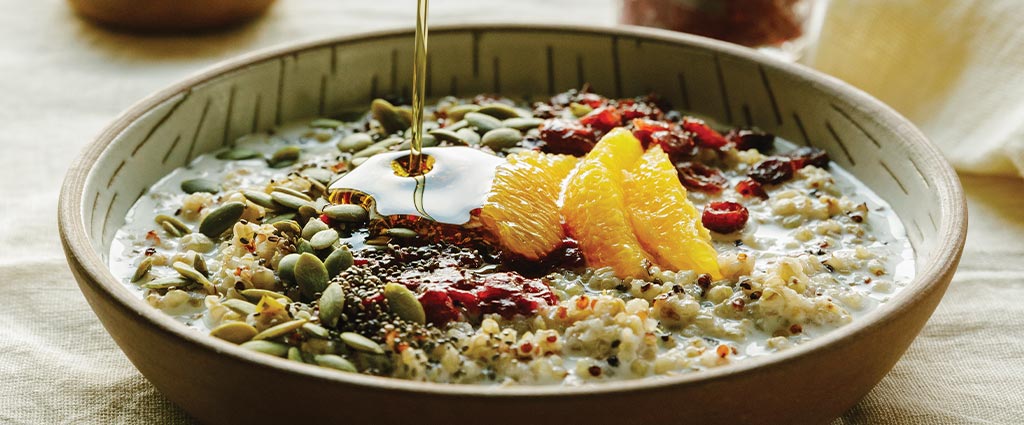Cooking with Cranberries: Benefits and How-To
These tart berries are delicious fresh or dried.
Cooking with Cranberries: Benefits and How-To
These tart berries are delicious fresh or dried.
What are they?
A cranberry is an evergreen shrub that is grown in wet habitats in Northeastern and North Central areas of the United States. In fact, there are more than 100 varieties of cranberries grown in North America. Cranberries are naturally low in sugar and high in acidity, resulting in an especially tart taste.
RECIPES USING CRANBERRIES
What are its potential health benefits?
Historically, cranberries have been used as a natural treatment for urinary tract infections (UTI). Cranberries are a potent source of unique polyphenol antioxidant substances that may help to prevent bacteria from sticking to the lining of the urethra, thus helping to prevent bacteria infection of the tissue, and decreasing UTI risk. Recently, the U.S. Food and Drug Administration (FDA) recognized the relationship between the consumption of cranberry products and the reduced risk of recurrent UTIs in healthy women. Additionally, researchers continue to examine cranberry’s potential impacts on oral and gut health, as well as chronic disease, such as cancer, diabetes and cardiovascular disease.
How do you cook with them?
Cranberries can be consumed in a variety of forms, including fresh, dried or juiced. Dried cranberries typically include added sugar to improve their palatability. Reduced sugar varieties are a great option to add to oatmeal, cereal or trail mix, or you can snack on them as is. They are also a delicious addition to a salad. Swap them out for other fruits in baked recipes like fruit breads, cookies and muffins. If you prefer cranberry juice, look for varieties with no added sugar and at least 27 percent cranberry juice. Consider mixing 4 ounces of a 100 percent cranberry juice with 4 ounces of sparkling water as a refreshing way to enjoy the benefits of cranberries. While cranberry supplements are available, consuming whole cranberries is preferred, as this helps to deliver other important nutrients such as fiber.
A few tips and tricks:
- When you don't have fresh cranberries, you can use dried cranberries—you just have to rehydrate them first. Soak the cranberries in hot water and let them stand for 15 to 20 minutes and strain before using in a recipe.
- Cranberries can be easily chopped up by pulsing in a food processor.
- Frozen fresh cranberries will last for about a year in the freezer.
What are they?
A cranberry is an evergreen shrub that is grown in wet habitats in Northeastern and North Central areas of the United States. In fact, there are more than 100 varieties of cranberries grown in North America. Cranberries are naturally low in sugar and high in acidity, resulting in an especially tart taste.
RECIPES USING CRANBERRIES
What are its potential health benefits?
Historically, cranberries have been used as a natural treatment for urinary tract infections (UTI). Cranberries are a potent source of unique polyphenol antioxidant substances that may help to prevent bacteria from sticking to the lining of the urethra, thus helping to prevent bacteria infection of the tissue, and decreasing UTI risk. Recently, the U.S. Food and Drug Administration (FDA) recognized the relationship between the consumption of cranberry products and the reduced risk of recurrent UTIs in healthy women. Additionally, researchers continue to examine cranberry’s potential impacts on oral and gut health, as well as chronic disease, such as cancer, diabetes and cardiovascular disease.
Try Cranberry
Today, it is used primarily for urinary tract infections (UTIs).
How do you cook with them?
Cranberries can be consumed in a variety of forms, including fresh, dried or juiced. Dried cranberries typically include added sugar to improve their palatability. Reduced sugar varieties are a great option to add to oatmeal, cereal or trail mix, or you can snack on them as is. They are also a delicious addition to a salad. Swap them out for other fruits in baked recipes like fruit breads, cookies and muffins. If you prefer cranberry juice, look for varieties with no added sugar and at least 27 percent cranberry juice. Consider mixing 4 ounces of a 100 percent cranberry juice with 4 ounces of sparkling water as a refreshing way to enjoy the benefits of cranberries. While cranberry supplements are available, consuming whole cranberries is preferred, as this helps to deliver other important nutrients such as fiber.
A few tips and tricks:
- When you don't have fresh cranberries, you can use dried cranberries—you just have to rehydrate them first. Soak the cranberries in hot water and let them stand for 15 to 20 minutes and strain before using in a recipe.
- Cranberries can be easily chopped up by pulsing in a food processor.
- Frozen fresh cranberries will last for about a year in the freezer.
ABOUT THE AUTHOR
Laura N. Brown (MS, RDN, LD, ACSM-CPT) has a simple food philosophy: There’s no such thing as bad food, only portion sizes that need a little attention. Laura helps patients craft a nutrition plan to match their lifestyle and tastebuds. Outside of work, Laura enjoys hiking with her dog and family as well as musical theatre. Combining her love of music and nutrition, she had a three-year stint as a performing artist… singing and rapping about healthy foods!
Did you know? You can meet virtually with a Kroger dietitian to help you achieve your personal wellness nutrition goals. Learn more about Telenutrition.
ABOUT THE AUTHOR
Laura N. Brown (MS, RDN, LD, ACSM-CPT) has a simple food philosophy: There’s no such thing as bad food, only portion sizes that need a little attention. Laura helps patients craft a nutrition plan to match their lifestyle and tastebuds. Outside of work, Laura enjoys hiking with her dog and family as well as musical theatre. Combining her love of music and nutrition, she had a three-year stint as a performing artist… singing and rapping about healthy foods!
Did you know? You can meet virtually with a Kroger dietitian to help you achieve your personal wellness nutrition goals. Learn more about Telenutrition.







Share this Post